We might want to see glaciers before they’re gone–but that doesn’t have to mean we should ignore what’s making them disappear in the first place.
T
he helicopter lurched forward, tilting toward the rocky river valley below. Beyond the flash of rotor blades, I could see a vast, rippled mass of ice pouring out of the mountains. Suspended in the air above the Franz Josef Glacier/Kā Roimata o Hine Hukatere (the later is the original Māori name for the glacier), I should have felt exhilarated.
Franz Josef and Fox Glaciers are neighboring rivers of ice carving glittering paths from the South Island’s mountain tops almost to sea level. The glaciers are embedded in one of the most remote and rugged regions of New Zealand, an area with the sparsest population and highest rainfall in the country. Cloaked in a dense tangle of mossy rainforest, with the Southern Alps shielding the region from the rest of the country, the West Coast is a fantastic wilderness. Even so, these are two of the most accessible glaciers in the world. Visitors have flocked here to marvel at the ice since the late 1800s.

Like so many more before me, I was lured in by the majesty of Franz Josef Glacier. I wanted to see the blue ice, the ever-shifting caves, and crevasses. So I went on a heli hike, hitching a helicopter ride onto the glacier, followed by a 90-minute guided walk across the ice. An adventure dream in action.
Recommended Fodor’s Video
But sitting in the helicopter as it thwopped up the valley, I couldn’t ignore the gnawing sense of guilt in my gut. There I was, chasing a glacier beating a retreat from climate change in a helicopter churning through fossil fuels to get me there.
Walking On Thin Ice
For around a century, glacier guides at Franz Josef led visitors up the valley straight onto the ice. This came to an end in 2012, when climate change-induced melting meant this was no longer possible. Fox wasn’t far behind, with collapsing ice cutting off foot access a year later.
Amidst fears, the vanishing ice spelled the end of glacier tourism, glacier guiding businesses latched onto a new solution; helicoptering people up to the ice. Heli hikes boomed. Helicopters started zipping up and down the valley, making the six-minute hop above the crumbling ice of the lower glacier to the hard blue and white expanse at the top.
In 2019, there were 30,000 helicopter landings on Fox and Franz Josef Glaciers. This number doesn’t include scenic flights that whirl overhead without touching down.
While cramponing across the glacier, my guide pointed to a waterfall tumbling down the wall of the valley and commented on how remarkable it was. Not for its beauty, but because we could hear the noise of the water as it dashed itself against the rocks. Before Covid, he said, the stream of helicopters was so steady it was impossible to hear the waterfall above their constant rumbling. He says that the airspace above glacier country was the busiest in the Southern Hemisphere.
A December 2019 report from the Parliamentary Commissioner for the Environment into the environmental consequences of tourism singles out the sharp rise in emissions and loss of natural quiet. The report calls glacier heli-hikes an example of “a maladapted response” to describe the skewed logic of countering the impacts of climate change with increasing reliance on emission-intensive activities. In the long run, this maladaptive approach is unsustainable in every sense of the word.

The Retreat That Is Anything but Glacial
Over the course of the 20th century, both glaciers naturally moved through cycles of advance and retreat. But in the past 20 years, the accelerating decline, incontrovertibly linked to a warming climate, has become impossible to ignore.
Franz Josef’s retreat is particularly remarkable because of the glacier’s visibility. People who have lived in the area for the past few decades have been able to see the ice disappearing in front of them. In the past ten years, Franz Josef Glacier has lost close to a mile of ice. Between 2008 and 2018, Fox lost nearly 3000 feet.
By 2100, there may only be remnants of ice left at the head of the valley where Franz Josef Glacier sits.
Hiking Without the Helicopters
Helicoptering up to the glacier and cramponing across its surface was unique. But I couldn’t reconcile myself with the damage I was doing. If I could do it again, I wouldn’t. I preferred exploring local walking tracks. Hiking through native forests into the alpine tops, I found a profound sense of tranquility to go with the sweeping views without the exorbitant price tag of a helicopter tour.
If you’re looking for a lower-emission way to see the glaciers, several options depend on your experience and passion for hiking.
The Franz Josef Glacier/Kā Roimata o Hine Hukatere Walk is the most accessible track, leading to a viewing area. This is the best option for people who aren’t enthused about a steep hike, with a well-formed path that only takes around 30 minutes to return. The Fox Glacier South Side Walk is another gentle option, with a well-formed track following the Fox River up the valley to viewpoints of the Fox Glacier. It takes around two hours to return and is worth it for the luscious forest immersion alone.
Roberts Point Track is a five-hour hike to a spectacular lookout point for those up for more of a challenge. The track is adventurous, crossing swing bridges, side streams, and open areas of rock smoothed by ancient ice. The viewing platform sits at 2000 feet above sea level, giving you an incredible view of the glacier as well as the surrounding mountain peaks and river valley below.
The next option, Alex Knob, is an eight-hour hike best suited to fit and experienced walkers. However, there are several viewpoints along the way, so you can choose how far you go. The path is well formed and zigzags up to the Rata Lookout, from where you’ll get a first look at the glacier, and then on to Christmas Lookout, which also has stunning views. Finally, the track ascends the tree line and weaves through a snow tussock to the Alex Knob summit. On a clear day, you’ll be looking down onto the glacier and beyond to the surrounding landscape, with the Southern Alps unfolding concertina-like in different directions.
Finally, my personal favorite was the Mount Fox Route, an advanced hiking track for the most adventurous. It’s a tough climb to the summit, but the reward is views of Fox Glacier in one direction and the sea in the other. You need to set out on a clear day–at 4400 feet, the Mount Fox is often obscured by clouds–and allow eight hours return.
Before setting off on any of these trails, check in at the Westland Tai Poutini National Park Visitor Center for maps, advice, and updates on weather conditions.





The issue isn't one of using helicopters to see glaciers, it is one of using fossil-fuelled devices where other options exist that have less enviroment impact. These include using electric instead of gas-powered lawn mowers, chain saws, and other tools. It also includes limiting the use of any recreational fossil-fuelled devices like off-road vehicles, ATVs, hot air balloons, power boats, etc.